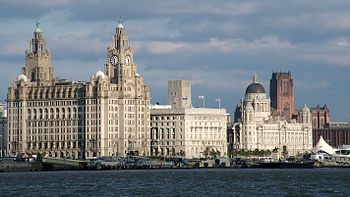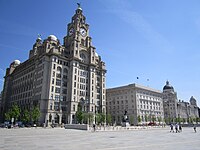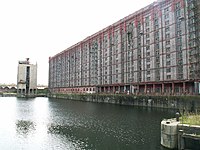Liverpool Maritime Mercantile City

The Liverpool Maritime Mercantile City is the waterside centre of the City of Liverpool in southern Lancashire, and a UNESCO-designated World Heritage Site. The designated are comprises six locations in the city centre of Liverpool including the Pier Head, Albert Dock and William Brown Street,[1] and includes many of the city's most famous landmarks.
The sites were given World Heritage Status in 2004 attributed to their representing 'the supreme example of a commercial port at a time of Britain's greatest global influence'.[2] In 2012, the site was inscribed on the List of World Heritage in Danger due to the proposed construction of Liverpool Waters project.

The sites were noted by UNESCO as follows:
- Criterion (ii): "Liverpool was a major centre generating innovative technologies and methods in dock construction and port management in the 18th and 19th centuries. It thus contributed to the building up of the international mercantile systems throughout the British Commonwealth."
- Criterion (iii): "The city and the port of Liverpool are an exceptional testimony to the development of maritime mercantile culture in the 18th and 19th centuries, contributing to the building up of the British Empire. It was a centre for the slave trade, until its abolition in 1807, and for emigration from northern Europe to America."
- Criterion (iv): "Liverpool is an outstanding example of a world mercantile port city, which represents the early development of global trading and cultural connections throughout the British Empire."
Locations
The Liverpool Maritime Mercantile City comprises six separate locations throughout the centre of the city, each of which relates to a different component and time in the Liverpool's maritime history.[3] The inscripted sites extend for approximately 4 km north-south along the city's waterfront and stretch approximately 1 km east-west.[4] In total they cover an aggregate area of 336 acres.[5]
The Pier Head
- Main article: Pier Head, Liverpool

The Pier Head is the focal point of Liverpool's waterfront and is dominated by three of its most recognisable landmarks, which are collectively referred to as the Three Graces:
- The Liver Building;
- The Port of Liverpool Building and
- The Cunard Building.
The 'Three Graces' stand as a testament to the great wealth in the city during the late 19th and early 20th century when Liverpool was one of the most important ports in the world.[6] In the early twentieth century ideas were put forward for a 'fourth grace', in particular a proposal by the architect Will Alsop for a building known as The Cloud, which thankfuluy was rejected in 2004. Today, in what would have been its place, a new Museum of Liverpool opened on 19 July 2011.[7][8]
Behind the Port of Liverpool building is the art deco George's Dock Ventilation Tower, whose design is heavily influenced by Egyptian architectural styling.[9] Also a part of the site is the old George's Dock wall, which dates from the late 18th century, as well as several memorials, including one built to honour the engineers who remained at their post as the RMS Titanic sank.[10]
Listed Buildings[6]
|
|
The Albert Dock
The Albert Dock is a complex of dock buildings and warehouses located to the south of the Pier Head. Designed by Jesse Hartley and Philip Hardwick and opened in 1846, the Albert Dock warehouses were the first in the world to be entirely fireproof, due to their construction from only iron, brick and stone, with no structural wood.[11] The dock was home to many advances in docking technology including being the first to have hydraulic cranes.[12] During Second World War the buildings suffered significant damage and general docking decline in the city after the end of the war saw them fall rapidly into disrepair. In the 1980s the area underwent massive regeneration after the creation of the Merseyside Development Corporation and the complex was reopened to the public in 1984, as part of the tall ships festival. Today they form a focal point for tourism in the city, being home to Tate Liverpool, Merseyside Maritime Museum and The Beatles Story. They also constitute the largest single collection of Grade I listed buildings anywhere in the UK.[13]
Listed Buildings[14]
|
|

The Stanley Dock Conservation Area
The Stanley Dock Conservation area is located to the north of the Pier Head and includes huge swathes of Liverpool's docking heartland. Within the site are several docks including Stanley Dock, Collingwood Dock, Salisbury Dock and Clarence Graving Dock; parts of the Leeds Liverpool Canal and associated canal locks; and many smaller features such as bridges, bollards and capstans.[15] Two of the Clarence Graving Docks are notable as the oldest docks still in use in the city today, dating back to 1830, although their full development wasn't completed until 1848.[16] Amongst the buildings in the area are the Victoria Clock Tower and Stanley Dock Tobacco Warehouse, one of the largest brick buildings in the world.[17]
Listed Buildings[15]
- Warehouse on North Side of Stanley Dock (Grade II*)
- Bonded Tea Warehouse, Great Howard Street (Grade II)
- Clarence Graving Docks (Grade II)

- Boundary Wall from Collingwood Dock to Huskisson Dock (Grade II)
- The Dock Master's Office, Salisbury Dock (Grade II)
- Salisbury, Collingwood and Stanley, Nelson and Bramley-Moore Dock Retaining Walls (Grade II)
- Stanley Dock Tobacco Warehouse (Grade II)
- Entrances to Stanley Dock Complex (Grade II)
- Canal Locks between Stanley Dock and Leeds and Liverpool Canal (Grade II)
- Princes Dock Boundary Wall and Piers (Grade II)
- Salisbury, Collingwood and Stanley, Nelson and Bramley-Moore Dock Retaining Walls (Grade II)
- Hydraulic Tower West of North Stanley Warehouse (Grade II)
- Victoria Tower (Grade II)
- Warehouse South of Stanley Tobacco Warehouse (Grade II)
- Waterloo Warehouse (Grade II)
Duke Street Conservation Area/ Ropewalks
The Ropewalks site comprises the south western component of the Duke Street conservation area, as well as two warehouses on College Lane and Bluecoat Chambers on School lane. The location was one of the first areas in the city to develop when Liverpool was an emerging port,[18] with Bluecoat Chambers being the oldest surviving building in Liverpool city centre, dating back to 1715.[19] Its proximity to the Old Dock, the world's first enclosed wet dock,[20] meant it was the location of the city's first property speculators who built both warehousing and residential premises along Duke Street, Hannover Street, and Bold Street. The area soon developed a cosmopolitan feel being home to various types of people including sea captains, merchants, traders and artisans. Today the area is known as Ropewalks, a reference to the large number of roperies present in the area when Liverpool was one of the busiest ports in the world during the 18th and 19th centuries.[18]
Listed Buildings[18]
- Bluecoat Chambers (Grade I)
- 105 Duke Street (Grade II)
- The Bridewell (Grade II)
- Thomas Parr's House and Warehouse (Grade II)
- 12 Hanover Street (Grade II)
- 33 Argyle Street (Grade II)
The 'Commercial Quarter'/Castle Street Conservation Area
This part of the World Heritage Site is focused around what would have previously been mediæval Liverpool and includes Castle Street dominated by Trials Hotel at one end and the Town Hall at the other linking Old Hall Street by Exchange Flags, Victoria Street, Water Street and Dale Street. Today a centre for commercial activity in the city, the area was included due to the nature of its street development over three centuries and the grandeur of its architecture and monuments.[21]

Listed Buildings
|
|
The 'Cultural Quarter'/ William Brown Street Conservation Area


The William Brown street area is the central point for many of Liverpool's civic buildings forming a so-called 'cultural quarter'. Amongst the buildings that are focal to this part of the WHS are St George's Hall, Lime Street Station, the Walker Art Gallery, the World Museum Liverpool, the former Great North Western Hotel and the entrance to the Queensway Tunnel.[22]
Listed Buildings[23]
|
|
Outside links
| ("Wikimedia Commons" has material about Liverpool Maritime Mercantile City) |
References
- ↑ "Liverpool – Maritime Mercantile City". UK Local Authority World Heritage Forum. Archived from the original. Template:Citation error. http://web.archive.org/web/20080423041054/http://www.lawhf.gov.uk/LAWHF/liverpool.htm. Retrieved 2008-10-09.
- ↑ "Welcome to Liverpool World Heritage". Liverpool City Council. http://www.liverpoolworldheritage.com/. Retrieved 2008-10-09.
- ↑ "Liverpool - Maritime Mercantile City". Visit Britain. http://www.visitbritain.com/en/things-to-see-and-do/interests/history-and-heritage/map/maritime-mercantile-city.aspx. Retrieved 2008-10-09.
- ↑ Liverpool City Council (2005), p17
- ↑ Liverpool City Council (2005), p26
- ↑ 6.0 6.1 "Pier Head". World Heritage Liverpool. http://www.liverpoolworldheritage.com/visitingthewhs/areas/pierhead/index.asp. Retrieved 2008-12-10.
- ↑ "Museum of Liverpool". Liverpool museums. http://www.liverpoolmuseums.org.uk/mol/about/. Retrieved 6 February 2012.
- ↑ "Building a New Museum". National Museums Liverpool. http://www.liverpoolmuseums.org.uk/mol/. Retrieved 2008-10-30.
- ↑ "George's Dock Ventilation". Liverpool World Heritage. http://www.liverpoolworldheritage.com/visitingthewhs/areas/pierhead/georgesdockventilation.asp. Retrieved 2008-12-10.
- ↑ "Memorial to the Engine Room Heroes of the Titanic". Liverpool World Heritage. http://www.liverpoolworldheritage.com/visitingthewhs/areas/pierhead/memorialtoengineroomheroes.asp. Retrieved 2008-12-10.
- ↑ Jones, Ron (2004). The Albert Dock, Liverpool. RJ Associates Ltd. pp. 83.
- ↑ Jones, Ron (2004). The Albert Dock, Liverpool. RJ Associates Ltd. pp. 46.
- ↑ Helen Carter (2003-03-07). "Glory of Greece, grandeur of Rome ... and docks of Liverpool". Guardian Unlimited. http://arts.guardian.co.uk/cityofculture2008/story/0,,950372,00.html. Retrieved 2007-03-27.
- ↑ "The Albert Dock Conservation Area". Liverpool World Heritage. http://www.liverpoolworldheritage.com/visitingthewhs/areas/albertdock/index.asp. Retrieved 2009-03-11.
- ↑ 15.0 15.1 "The Stanley Dock Conservation area". Liverpool World Heritage. http://www.liverpoolworldheritage.com/visitingthewhs/areas/stanleydock/index.asp. Retrieved 2009-03-07.
- ↑ "Clarence Graving Docks". Liverpool World Heritage. http://www.liverpoolworldheritage.com/visitingthewhs/areas/stanleydock/clarencegravingdocks.asp. Retrieved 2009-03-09.
- ↑ "The Stanley Dock Tobacco Warehouse". Liverpool World Heritage. http://www.liverpoolworldheritage.com/visitingthewhs/areas/stanleydock/tobaccowarehouse.asp. Retrieved 2008-11-07.
- ↑ 18.0 18.1 18.2 "Duke Street Area/Ropewalks". Liverpool World Heritage. http://www.liverpoolworldheritage.com/visitingthewhs/areas/dukestreet/index.asp. Retrieved 2008-11-01.
- ↑ Nikolaus Pevsner: Pevsner Architectural Guides
- ↑ "Trading Places: Old Dock History". National Museums Liverpool. http://www.liverpoolmuseums.org.uk/nof/docks/access/dock_history7.html. Retrieved 2008-11-01.
- ↑ "Castle/Dale/Old Hall St Commercial Centre". Liverpool World Heritage. http://www.liverpoolworldheritage.com/visitingthewhs/areas/castlestreet/index.asp. Retrieved 2008-11-06.
- ↑ "William Brown St Conservation Area". Liverpool World Heritage. http://www.liverpoolworldheritage.com/visitingthewhs/areas/williambrownstreet/index.asp. Retrieved 2008-11-07.
- ↑ "William Brown St Conservation Area". Liverpool World Heritage. http://www.liverpoolworldheritage.com/visitingthewhs/areas/williambrownstreet/index.asp. Retrieved 2009-09-14.
- Liverpool City Council (2005). Maritime Mercantile City: Liverpool. Liverpool University Press. ISBN 1-84631-006-7.
- Oevermann, H., ed (2014). Industrial Heritage Sites in Transformation: Clash of Discourses. Routledge. ISBN 978-0415745284.
| World Heritage Sites in the United Kingdom |
|---|
|
Bath • Blaenavon Industrial Landscape • Blenheim Palace • Canterbury Cathedral, St Augustine's Abbey & St. Martin's Church • Castles and Town Walls of King Edward I • Cornwall and West Devon Mining Landscape • Derwent Valley Mills • Durham Castle & Cathedral • Edinburgh Old Town & New Town • Forth Bridge • Frontiers of the Roman Empire: Antonine Wall & Hadrian's Wall • Giant's Causeway • Ironbridge Gorge • Jurassic Coast • Kew Gardens • Liverpool Maritime Mercantile City • Maritime Greenwich • New Lanark • Heart of Neolithic Orkney • Pontcysyllte Aqueduct • St Kilda • Saltaire • Stonehenge, Avebury & Associated Sites • Studley Royal Park & Fountains Abbey • Tower of London • Palace of Westminster, Westminster Abbey & St Margaret's Church |
